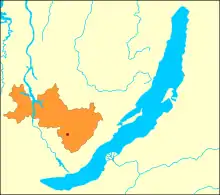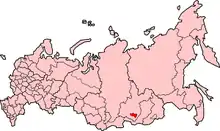Ust-Orda Buryat Okrug
Ust-Orda Buryat Okrug (Russian: Усть-Орды́нский Буря́тский о́круг; Buryat: Усть-Ордын (Усть-Ордагай) Буряадай тойрог Ust’-Ordyn (Ust’-Ordagay) Buryaaday toyrog), or Ust-Orda Buryatia, is an administrative division of Irkutsk Oblast, Russia.[1] It was a federal subject of Russia (an autonomous okrug of Irkutsk Oblast) from 1993 to January 1, 2008, when it merged with Irkutsk Oblast. It also had autonomous okrug status from September 26, 1937 to 1993. Prior to the merger, it was called Ust-Orda Buryat Autonomous Okrug (Усть-Орды́нский Буря́тский автоно́мный о́круг). It is one of the two Buryat okrugs in Russia, the other one is Agin-Buryat Okrug in Zabaykalsky Krai.





It has an area of 22,138.1 square kilometers (8,547.6 sq mi). Population: 125,177 (2010 Census).[2]
The settlement of Ust-Ordynsky is the autonomous okrug's administrative center and its most populous inhabited locality.
Merger
In a referendum held on April 16, 2006, the majority of residents in Irkutsk Oblast and Ust-Orda Buryat Autonomous Okrug agreed to the unification of the two regions. According to regions' electoral commissions, 68.98% of residents of Irkutsk Oblast and 99.51% of residents in Ust-Orda Buryatia took part in the vote, making it one of the best attended plebiscites in the country since the 2003 Russian election. The merger was approved by an absolute majority of the electorate: by 89.77% in Irkutsk Oblast and by 97.79% in Ust-Orda Buryatia. The enlarged Irkutsk Oblast has officially come into existence on January 1, 2008.[3][4]
Administrative divisions
The okrug is divided into six administrative districts:
Demographics
- Population: 125,177 (2010 Census);[2] 135,327 (2002 Census);[5] 136,306 (1989 Census).[6]
Vital statistics
| Average population (x 1000) | Live births | Deaths | Natural change | Crude birth rate (per 1000) | Crude death rate (per 1000) | Natural change (per 1000) | |
|---|---|---|---|---|---|---|---|
| 1970 | 146 | 2,813 | 1,175 | 1,638 | 19.3 | 8.0 | 11.2 |
| 1975 | 138 | 3,014 | 1,311 | 1,703 | 21.8 | 9.5 | 12.3 |
| 1980 | 132 | 3,193 | 1,346 | 1,847 | 24.2 | 10.2 | 14.0 |
| 1985 | 132 | 3,546 | 1,397 | 2,149 | 26.9 | 10.6 | 16.3 |
| 1990 | 128 | 3,383 | 1,325 | 2,058 | 26.5 | 10.4 | 16.1 |
| 1991 | 129 | 3,101 | 1,424 | 1,677 | 24.0 | 11.0 | 13.0 |
| 1992 | 131 | 2,770 | 1,560 | 1,210 | 21.1 | 11.9 | 9.2 |
| 1993 | 132 | 2,379 | 1,742 | 637 | 18.0 | 13.2 | 4.8 |
| 1994 | 132 | 2,385 | 1,943 | 442 | 18.1 | 14.7 | 3.4 |
| 1995 | 132 | 2,186 | 1,872 | 314 | 16.5 | 14.2 | 2.4 |
| 1996 | 133 | 2,155 | 1,704 | 451 | 16.2 | 12.8 | 3.4 |
| 1997 | 134 | 2,010 | 1,787 | 223 | 15.0 | 13.3 | 1.7 |
| 1998 | 134 | 2,011 | 1,654 | 357 | 15.0 | 12.3 | 2.7 |
| 1999 | 135 | 2,018 | 1,923 | 95 | 15.0 | 14.3 | 0.7 |
| 2000 | 135 | 1,932 | 2,004 | - 72 | 14.3 | 14.9 | -0.5 |
| 2001 | 135 | 1,986 | 1,967 | 19 | 14.7 | 14.6 | 0.1 |
| 2002 | 135 | 2,011 | 2,004 | 7 | 14.9 | 14.9 | 0.1 |
| 2003 | 134 | 1,986 | 2,023 | - 37 | 14.9 | 15.1 | -0.3 |
| 2004 | 132 | 2,058 | 2,174 | - 116 | 15.6 | 16.5 | -0.9 |
| 2005 | 130 | 1,968 | 2,138 | - 170 | 15.1 | 16.4 | -1.3 |
| 2006 | 128 | 2,142 | 1,867 | 275 | 16.7 | 14.6 | 2.1 |
| 2007 | 127 | 2,433 | 1,653 | 780 | 19.1 | 13.0 | 6.1 |
| 2008 | 126 | 2,827 | 1,719 | 1,108 | 22.4 | 13.6 | 8.8 |
| 2009 | 126 | 2,906 | 1,648 | 1,258 | 23.1 | 13.1 | 10.0 |
| 2010 | 125 | 2,785 | 1,771 | 1,014 | 22.3 | 14.2 | 8.1 |
Ethnic groups
Of the 135,327 residents (as of the 2002 Census), 38 (0.02%) chose not to specify their ethnic background. Of the rest, residents identified themselves as belonging to 74 ethnic groups, including Russians (54.4%), Buryats (39.6%), Tatars (3%) and Ukrainians (0.96%)
| Ethnic group |
1959 Census | 1970 Census | 1979 Census | 1989 Census | 2002 Census | 2010 Census | 2020 Census | |||||||
|---|---|---|---|---|---|---|---|---|---|---|---|---|---|---|
| Number | % | Number | % | Number | % | Number | % | Number | % | Number | % | Number | % | |
| Buryats | 44,850 | 33.7% | 48,302 | 33.0% | 45,436 | 34.4% | 49,298 | 36.3% | 53,649 | 39.6% | 49,871 | 39,8% | 50,519 | 41,4% |
| Russians | 75,099 | 56.4% | 86,020 | 58.8% | 76,731 | 58.1% | 76,827 | 56.5% | 73,646 | 54.4% | 67,808 | 54,2% | 66,587 | 54,5% |
| Others | 13,122 | 9.9% | 12,090 | 8.3% | 9,986 | 7.6% | 9,745 | 7.2% | 8,032 | 5.9% | 7,498 | 6,0% | 4,961 | 4,1% |
See also
References
- [http://base.consultant.ru/cons/cgi/online.cgi?req=doc;base=LAW;n=68717;div=LAW;mb=LAW;opt=1;ts=EA2BD535A6F57731DCC3152CD4B22010 Федеральный конституционный закон №6-ФКЗ от 30 декабря 2006 года "Об образовании в составе Российской Федерации нового субъекта Российской Федерации в результате объединения Иркутской области и Усть-Ордынского Бурятского автономного округа"]. Статья 5. (Federal Constitutional Law #6-FKZ of December 30, 2006 On Creation of a New Federal Subject Within the Russian Federation as a Result of the Merger of Irkutsk Oblast and Ust-Orda Buryat Autonomous Okrug. Article 5) (in Russian)
- Russian Federal State Statistics Service (2011). Всероссийская перепись населения 2010 года. Том 1 [2010 All-Russian Population Census, vol. 1]. Всероссийская перепись населения 2010 года [2010 All-Russia Population Census] (in Russian). Federal State Statistics Service.
- Lenta.ru Archived May 29, 2006, at the Wayback Machine "Избиркомы объявили результаты референдума по созданию новой Иркутской области" (Electoral Commissions Announced the Results of the Referendum on Creation of New Irkutsk Oblast) April 20, 2006(in Russian)
- [http://old.lenta.ru/news/2008/01/01/irkutsk/ Archived July 16, 2011, at the Wayback Machine С 1 января в России сократилось число субъектов федерации> Lenta.ru January 1, 2008 (in Russian)
- Russian Federal State Statistics Service (May 21, 2004). Численность населения России, субъектов Российской Федерации в составе федеральных округов, районов, городских поселений, сельских населённых пунктов – районных центров и сельских населённых пунктов с населением 3 тысячи и более человек [Population of Russia, Its Federal Districts, Federal Subjects, Districts, Urban Localities, Rural Localities—Administrative Centers, and Rural Localities with Population of Over 3,000] (XLS). Всероссийская перепись населения 2002 года [All-Russia Population Census of 2002] (in Russian).
- Всесоюзная перепись населения 1989 г. Численность наличного населения союзных и автономных республик, автономных областей и округов, краёв, областей, районов, городских поселений и сёл-райцентров [All Union Population Census of 1989: Present Population of Union and Autonomous Republics, Autonomous Oblasts and Okrugs, Krais, Oblasts, Districts, Urban Settlements, and Villages Serving as District Administrative Centers]. Всесоюзная перепись населения 1989 года [All-Union Population Census of 1989] (in Russian). Институт демографии Национального исследовательского университета: Высшая школа экономики [Institute of Demography at the National Research University: Higher School of Economics]. 1989 – via Demoscope Weekly.